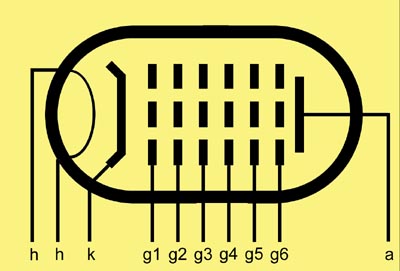|

The octode was essentially a development of the Heptode or Pentagrid Converter. The sixth and final grid before the anode being tied to the cathode as a suppressor of secondary emission electrons.
The typical use configuration would be the local oscillator would be formed between grid one and grid two. Grids three and five would be electrostatic screens or screen grids. The signal would be coupled to the frequency changer through grid four, the latter normally taken to the top cap for added isolation.
A problem with the Heptode when used at the higher Short Wave frequencies (20 - 30 MHz) was the time the electrons took to pass through the valve making the converter unsuitable for the task. Philips in 1938 developed the beam octode with a focused stream of electrons to overcome the transit time problem. The first such valve introduced into the United Kingdom was the type EK3 from Mullard. The base used was the Philips continental side contact Ct8.
|